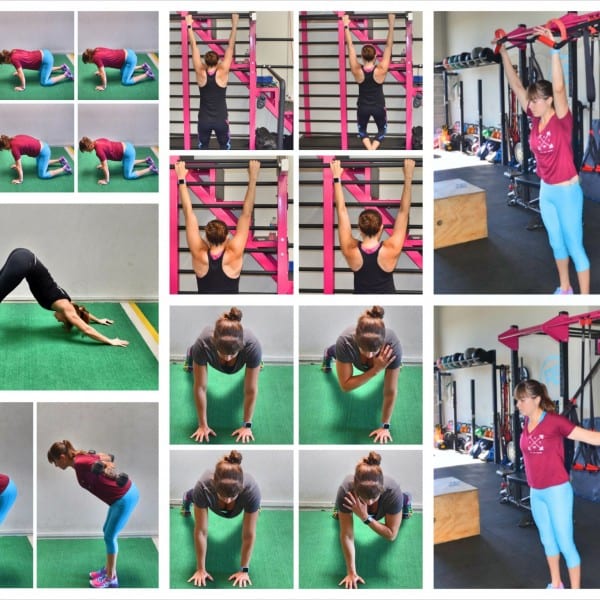
Keep Those Shoulders Healthy – Prevent and Alleviate Shoulder Pain and Injury
Because most of us sit hunched over for a majority of the day, whether it’s at a desk, in the car or even watching TV, many of us are at risk for shoulder pain and injury.
That constant flexion of your spine, forward rounded shoulders and forward head position creates tight muscles and poor alignment, which leads to imbalances, compensations and eventually injury – specifically shoulder injury.
And it doesn’t help that all too many of us then want to do a ton of pressing exercises at the gym.
But many of us can’t avoid the computer or driving in a car. And we don’t want to give up doing exercises that we love or watching the TV.
And we could drive ourselves crazy obsessing over all the ways throughout the day that we sit or stand or lean or move that could be perpetuating and causing the imbalances.
So then, how do we correct our posture and keep our shoulders healthy without having to quit our jobs or stop driving our cars?
Below are some tips and exercises to help you improve your posture and shoulder health to prevent and alleviate shoulder pain and injury.
Prevent and Alleviate Shoulder Pain and Injury
Improving your posture and reversing the effects of sitting hunched over for most of the day is important to keeping your shoulders healthy and injury free.
And the most obvious way to do this is to simply set up your desk or car in a way that allows you to sit with better posture. However, this alone is probably not enough because there are ways you don’t even realize that you are sabotaging yourself and your posture throughout the day.
That is why it is important to include a program to open up your chest, relax your upper traps and activate the big muscles of your back. By including exercises in your workout routine that reverse the effects of sitting hunched over, you can help fight against poor movement patterns and imbalances and even help prevent yourself from repeating them.
To prevent aches and pains and injury, you need to follow a 4 Step Program – foam rolling, stretching, activation and strengthening. If your program is missing any one of these pieces, you may not be getting the fastest or best results you could be getting.
Below are exercises for each of the 4 Steps to Prevent Injury that you can include in your current workout routine.
Foam Rolling Moves For Healthy Shoulders
Foam rolling is the first piece you need to include if you want to start alleviating and preventing aches and pains. Foam rolling loosens tight muscles and helps you start restoring them to their proper length-tension relationships.
Because we sit hunched over a computer for 9 hours a day, muscles often get tight that then cause the smaller muscles of our shoulders to become overworked. Tight muscles can also affect the alignment of our shoulder and upper body, causing things to not have full range of motion and therefore cause imbalances, compensations and injuries.
That is why foam rolling is an important part of your program. It will help relax and loosen tight muscles so that you can then stretch them and get the proper muscles activated and working to correct those imbalances and compensations.
Below are 6 foam rolling moves you can use to open up your upper body to help prevent and alleviate shoulder injury. For more moves, and a video of all of these moves, check out these 11 Upper Body Foam Rolling Moves.
Chest Foam Rolling – A tight chest can lead to shoulder pain and dysfunction. It can cause the big muscles of your back to not activate and work correctly so that you end up overusing the small muscles around your shoulder joint.
It can also cause you to round forward and cause forward shoulders and it’s often caused by sitting hunched over a computer all day combined with lots of pushing exercises.
To roll out your chest, you can use a larger foam ball against the ground or a smaller ball in a doorway.
To roll out your chest in a doorway, stand facing the wall besides the doorway and place the ball between your chest and the wall. You want to be right on the edge of the wall with the ball right inside your shoulder joint so that you can extend your arm forward through the doorway to roll out your chest.
Start with the ball in your chest besides your shoulder and below your collarbone. Lean into the ball against the wall and raise the arm on the side you are digging into up toward the ceiling and back down.
Because you are in a doorway, you can raise the arm straight out in front of you as you raise the arm very slowly up toward the ceiling and then lower it back down toward the ground.
As you raise your arm slowly up and down, you can also roll the ball away from your shoulder under your collarbone. You can roll all the way toward your sternum. Hold on any tight spots as you move your arm.
You can use the ball along the muscles below your collarbone and even down around your shoulder toward your armpit. Hold on any tight spots you find and even lift and lower your arm as you hold on those spots.
Then switch and roll out your other side.
Lat Foam Rolling – Your lats also affect the movement of your shoulder and tight lats can cause a lack of mobility in your shoulder joint, which can cause imbalances and compensations and lead to pain and injury.
Your lats can also affect the movement of your scapulae aka your scapular retraction or even scapular downward rotation.
So loosening up your lats is essential to proper shoulder health and mobility.
To roll out your lats, you can use a ball against the wall or ground or a roller. A roller allows you to more easily work down the expanse of your entire lat.
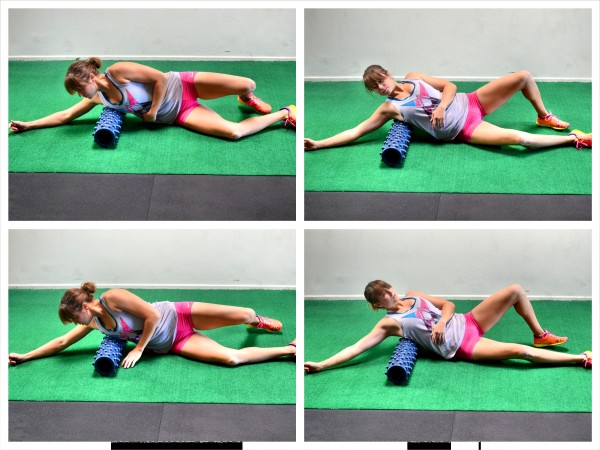
To roll out your lats using a roller, start by lying on your side with a roller under one armpit. Extend that arm up above the roller so that you can place the roller right to the side of your back under your armpit.
Then rock forward and backward on the roller, rotating your chest toward the ground and then up toward the ceiling as you roll on the roller so it hits toward your ribs and then toward your back.
Hold on any tight spots you find then move it lower down the side of your back. Hold on any tight spots as you go and make sure to rock forward and backward as you make your way down your side.
As you work down your side, you may want to rotate slightly more toward your back. Work all the way from your armpit to about the end of your rib cage.
Be careful when rolling lower down your back into your low back. You do not want to arch over the roller and hyperextend your low back. Make sure to hold on any tight spots as you work over your lat to help the muscle release and relax.
You can even use a ball to target any areas of tightness that you find.
Upper Back Foam Rolling – If you sit at a desk all day, it is likely that your upper back, especially your upper traps are overactive and tight causing, not only potentially neck pain, but also shoulder pain.
And because those smaller muscles are tight, they can inhibit the larger muscles of your back from engaging correctly and working to support your shoulders as well as help your shoulder joint move correctly.

To loosen up your upper back and upper traps, a small ball against a wall works best. You can also use a ball against the ground; however, the ball will dig in more and you will have a little less control maneuvering around. A peanut can also be a great tool to use along your upper back. (Check out how to make your own Peanut here.)
To roll out your traps and upper back using a ball, stand with your back to the wall and place the ball right behind and to one side of the base of your neck. Press back into the ball.
Then roll the ball up toward the top of your trap at the base of your neck and even out toward your shoulder. To roll the ball up toward the top of your trap, you may have to rotate your body, moving your shoulder back toward the wall as you sort of angle yourself with your head tilted and the side of your head against the wall.
Hold on any tight spots you find there. You may find you need to angle your body more or less to get the right amount of pressure and the right angle.
You can then roll the ball back toward your shoulder blades and then down your back right under your shoulder blades. You can work all the way down your shoulder blades. And, as you work along your shoulder blades, you can even pull the arm on that side across your chest or lift and lower it to help you dig in more to any knots or trigger points.
You can work along both shoulder blades, holding on any tight spots as you move your arm across your body and even lift and lower it up and down. Holding while moving your arm can help loosen the tight spot.
You can also work along the muscles next to your spine and across the entire expanse of your upper back. Just make sure to hold on any tight spots and avoid rolling over bone.
Thoracic Extension – When we sit hunched over a computer all day, our spines are in flexion. This rounded, forward flexion, creates tight muscles, imbalances and compensations.
It causes us to have limited thoracic extension, which means that, when we try to do a movement that requires thoracic extension, we will seek out extra mobility from other areas of our body to compensate for the lack of thoracic mobility that we have.
Because we are asking other areas to compensate, we risk injury. And often when we have a lack of thoracic extension, an area that suffers is our shoulder.
You can work on Thoracic Extension using a peanut or a roller. The Wall Slides Stretching Exercise in the next section will also work on thoracic extension as well.
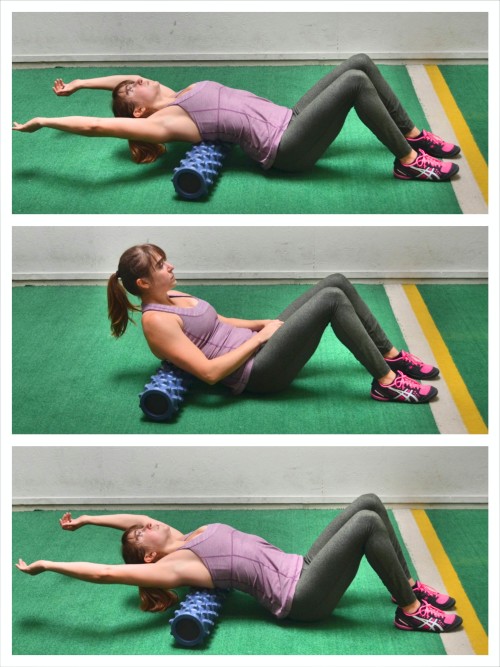
To work on your Thoracic Extension using a roller, place the roller on the ground and lie back over the roller with your butt on the ground, your knees bent and your feet on the ground. Make sure you start with the roller in your mid-back. You do not want to do this move with the roller in your low back or you could hyperextend your low back.
Cross your hands over your chest and, keeping your butt on the ground, extend your back over the roller. As you relax and extend back over the roller, reach your hands overhead and relax your head and neck. Try to touch the backs of your hands to the ground behind you without lifting your butt up off the ground or only extending from your low back. Focus on extending your mid and upper back over the roller.
Sit back up and cross your hands back over your chest. You can then repeat, relaxing and extending over the roller as you reach your arms back overhead.
Perform the extension a few times, especially if the area feels tight, and then move the roller higher up on your back and repeat. Hold for a second or two as you extend so that you can breathe and relax more over the roller.
Work all the way up your mid to upper back. Do not do this move on your lower back.
You can use a Rumble Roller, so a roller with “nobs” instead of a flat roller, if you want to dig in more. You can also use a Peanut and move your arms out by your sides and overhead as if drawing a snow angel as you relax over the Peanut.
Arm Foam Rolling – Your shoulder joint is moved and affected by the muscles of your upper body, including the muscles of your arm. Tightness in your arm could cause dysfunction and problems at the shoulder joint, which is why it is important to loosen up your bicep and your tricep.
Tightness in your upper arm can also cause issues at your elbow and wrist, which could later lead to shoulder injury even if the problem doesn’t start there. Therefore you need to make sure the muscles of your upper arm are loose and working correctly to prevent pain and injury up and down your arm.
To roll out your triceps and your biceps, you can use a ball or a roller. You will need to use them either against a wall or up on a box, table or bench. Using them against the ground won’t allow you to dig in enough.
Tricep Foam Rolling:
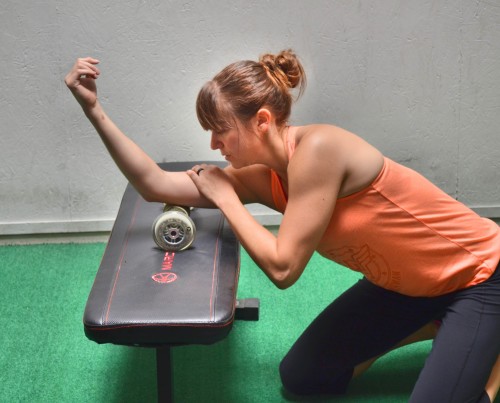
To roll out your triceps, you can use a ball or roller. Using a ball or roller, place it up on a desk or table with the backside of your upper arm (your tricep) on the roller or ball right above your elbow.
Press your arm down into the ball or roller using your other hand. This will help you apply more pressure to the muscle as you roll to help dig it out. Then rock your upper arm side to side very slightly, searching for any tight spots. When you find a tight area, hold on it and relax and breathe.
You can also extend and bend your elbow to flex and relax your tricep over the ball or roller to help release the tight spot.
Work your way up your tricep to your shoulder. You can even rock and work toward your inner and outer upper arm.
You can also use a ball or roller against a wall if you don’t have a table or desk.
Bicep Foam Rolling:
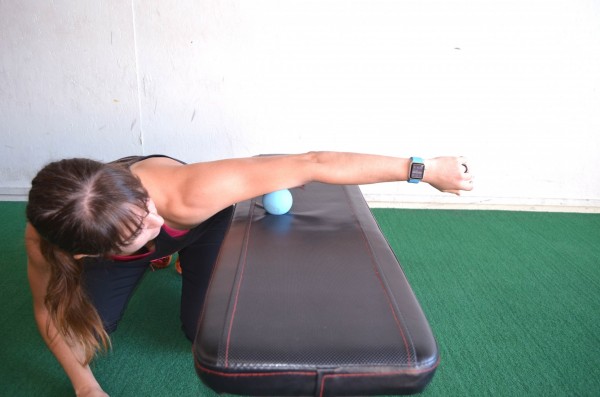
To roll out your biceps, you will place a ball or roller up on a table or desk like you did to roll out your triceps. You will then rotate your chest toward the ground and place your bicep down on the roller or ball right above the inside of your elbow.
Rock slightly side to side to dig out your bicep and hold on any tight spots. You can even flex and relax your bicep by bending and extending your elbow if your desk or table allows.
Work the roller up your bicep toward your shoulder, rocking side to side and holding on any tight spots.
If you don’t have a table or desk you can use, you can also do this against a wall although you may not be able to flex and extend your arm then.
Forearm Foam Rolling – Your forearms may not be connected to your shoulders directly, but if your forearm muscles are tight, you may end up with wrist and elbow pain. And pain or dysfunction at either one of those two joints, could lead to shoulder pain and injury.
When there is dysfunction anywhere on our body, that can cause imbalances and compensations in other areas as those areas try to make up for the lack of strength or mobility.
Our bodies try to make movements work and take the path of least resistance, which doesn’t necessarily mean the best movement patterns or correct movement patterns.
That’s why forearm tightness that leads to wrist or elbow problems can also cause shoulder pain and injury.
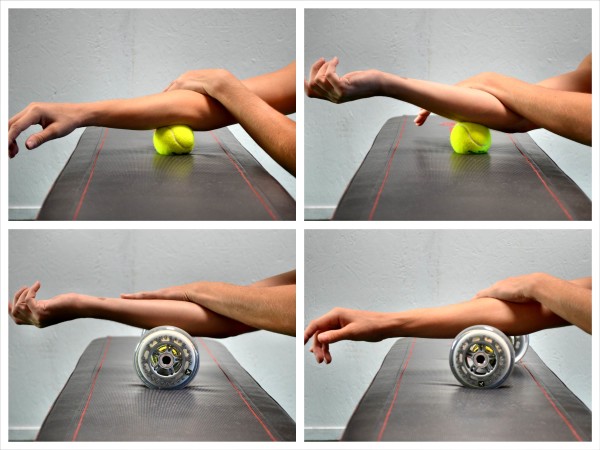
To roll out your forearm, place a small ball or roller up on a table or desk. Place your forearm on the ball with it right below your elbow. You can start with the underside of your forearm down on the ball.
Use your other hand to press down on your forearm to help place pressure on the ball. Start to make small circles on the ball to dig in more. Keep your forearm relaxed over the ball as you dig in and use the other hand to apply more pressure.
Hold on any tight spots. If you find a tight spot, you can also tense and relax your forearm to help the ball dig in further and the muscle relax. To tense and relax your forearm, flex and extend your wrist or even make a fist and then relax your hand.
After holding on any tight spots you find, roll the ball all along the fleshy part of the underside of your forearm. Once you’ve held on any tight spots on the underside of your forearm that you find, move to the outside of your forearm.
Make sure to roll out the outside and inside of your forearm as there can be trigger points in both spots.
Apply as much pressure as you can handle and use as small and hard a ball or roller as you can.
Stretches For Healthy Shoulders
Once you’ve rolled out any tight areas, it is time to start stretching and further loosening up those tight muscles to restore proper mobility around your shoulder joint.
You can use a combination of dynamic and static stretches to restore flexibility while also promoting a full range of motion as you stretch.
Below are 8 stretches to help keep your shoulders healthy and loosen up the tight muscles that may contribute to shoulder pain and injury.
Chest Stretch With Wave – If you sit all day, your chest is probably tight, which can contribute to shoulder problems. So any good workout program needs to include chest stretches.
And while the Standing Doorway Chest Stretch is a great move to use throughout the day when you get up from your desk to help keep your chest open and promote proper posture, that stretch can be made even better by adding in a “wave.”
The Chest Stretch with Wave, stretches the chest as it mobilizes the shoulder joint and targets different aspects that may be tight.
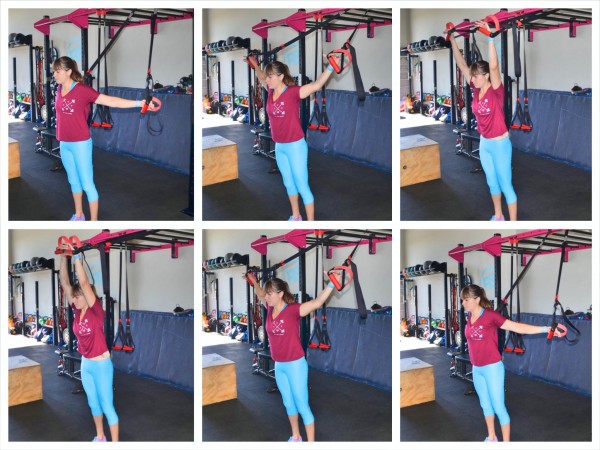
To do the Chest Stretch with Wave, you will need a suspension trainer, rings or even towels or resistance bands anchored behind you.
Using a Suspension Trainer, hold a handle in each hand and walk away from the anchor point with your back to the anchor point. Extend your arms straight out to your sides at shoulder height and walk away from the anchor point so that you feel a stretch in your chest.
You may have to adjust slightly backward or forward as you begin to do the wave, depending on your mobility.
Then, standing still with your arms starting out at shoulder height, raise your arms up overhead. Keep your arms straight as you extend overhead and even lean slightly forward to increase the stretch.
Hold for a second or two and then bring your arms out and down to the side, lowering them all the way back and down toward the ground. Keep your arms straight as you bring them down.
Feel the muscles of your chest and even around your shoulder stretching as you lower your arms down.
Then bring them back up out to the side and back overhead. Move in a fluid, smooth “wave” as you lift and lower. This movement also sort of looks like you are drawing a snow angel behind you.
Move slowly to wave the arms up and down. Make sure you are far enough out and leaning slightly forward so that you feel a stretch. If it is too much and you can’t move your arms in a full wave, move back slightly or don’t lean in as much.
Hold at any point that feels extra tight for a breath or two.
Kneeling Thoracic Extension and Lat Stretch – Shoulder pain and injury can be caused by a lack of thoracic extension as well as tight lats and even tight triceps. This move works to improve all three. It will help you work on extending your thoracic spine as you stretch your triceps and your lats.
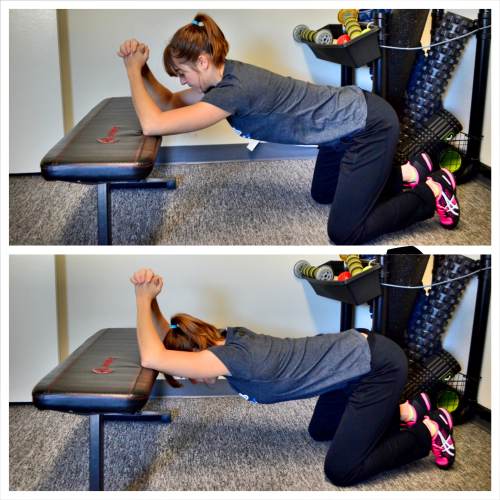
To do the Kneeling Thoracic Extension and Lat Stretch, you will need a box, table, bench or you can even use your desk chair. Kneel on the ground in front of the box or table and place your elbows up on it about shoulder-width apart. You can change the placement or your elbows, placing your elbows a bit closer together to change up the stretch, especially if you are more mobile to start. With your elbows up on the bench, make sure that you are kneeling far enough away that you have room to lean forward and over and drop your head between your elbows.
Then from the kneeling position with your elbows up on the bench, relax your chest and head over, sitting your butt back. Press your chest toward the ground as you extend your spine and feel a nice stretch down your triceps and lats as well as through your thoracic spine. Try to extend your back as much as possible as you press your chest toward the ground.
However, as you extend, make sure that you aren’t simply hyperextending your low back to drop your chest down toward the ground. Think about extending through your mid and upper back as you feel your triceps and lats stretch. Brace your abs to help keep your low back from extending to create the movement.
You can either hold here and breathe to stretch deeper or you can come out of the stretch and then relax back into it and try to get further with each rep.
If you really feel your elbows constantly sliding out on the bench, you can hold a dowel or even a towel between your hands to help keep everything in line.
Wall Slides – This is a great stretch to work on thoracic extension to keep your shoulders healthy while also learning to protect your low back. Often when we lack proper thoracic extension, we seek out extension from other areas of our body. And one area we often ask to compensate is our low back. So proper thoracic extension is not only important for our shoulder health, but also our low back health.
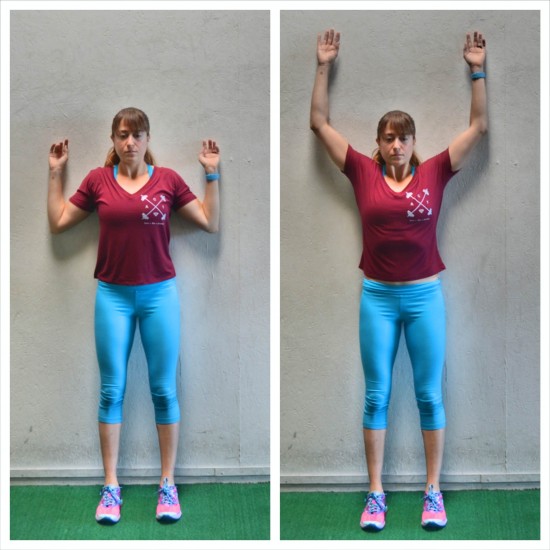
To do Wall Slides, stand with your back against a wall and your feet a few inches out from the wall. You can bend your knees slightly. Then press your low back into the wall as you relax your upper back against the wall. At no point through the movement should you allow your low back to leave the wall.
Bend your arms and place the back of your hands against the wall right outside your head.
Keeping your back firmly against the wall and your core tight, slide the back of your hands up the wall as far as possible. Then slide them back down.
Don’t slide them up further if your back is arching off the wall and you are getting the extension from your low back instead of your upper back. Repeat and each time try to get higher up the wall.
Thread The Needle – This is a great stretch to loosen up your neck, shoulders, chest and upper back. You can even feel it all the way down stretching your low back.
It is a great move to alleviate a lot of those tight muscles that could lead to shoulder pain while also loosening you up after sitting hunched over a computer all day.
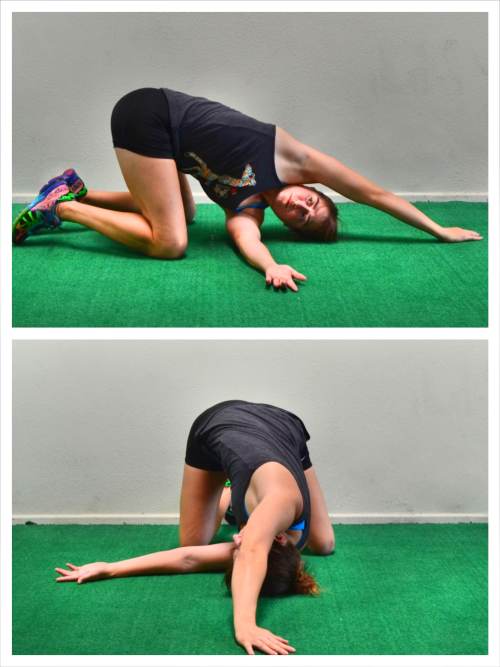
To do the Thread the Needle Stretch, kneel on the ground and then lean forward, reaching one arm overhead to place the palm on the ground as you reach the other one under your arm to relax the side of your head and body down to the ground. As you relax the side of your head and your bottom shoulder down, use the hand overhead to help rotate your chest open toward the ceiling.
You are “threading a needle” by reaching one arm through the “hole” created by the arm reaching overhead.
Breathe and relax into the stretch so that you feel a stretch down your neck and across your shoulder blades. Rotate your chest up and open. You can walk your top arm back behind your head to increase the stretch.
Hold and then thread the other arm under and through.
Hold each stretch for at least a second or two before switching. Sit back onto your heels if you can keep your head and shoulder on the ground.
Quadruped Shoulder Circles – Circles are a great way to improve the mobility of your shoulders because they move your shoulders through a full range of motion. And Quadruped Shoulder Circles are not only a great mobility exercise, but also a great move to improve your mind-body connection.
It takes a lot of coordination to circle your shoulders forward and backward in the quadruped position so take it slow and really focus on the circles. You will find they get better the more you do them.

To do Quadruped Shoulder Circles, set up on your hands and knees with your hands under your shoulders and your knees under your hips. Without bending your elbows, begin to circle your shoulders forward.
Bring them up toward your ears then circle them back toward your hips and back down and around. Try to make a big circle while keeping your arms straight.
Circle forward a few times then reverse the circles.
It make almost feel like you are circling your back around your shoulders, especially in reverse. Take it slow and focus on the circles. Don’t simply shrug and unshrug your shoulders.
Circle backward a few times, still not bending your elbows as you circle. Also, do not sit back on your heels as you move.
Shoulder Flossing – Shoulder Flossing is another great circling exercise to improve the mobility of your shoulders and work them through a full range of motion. This move can help stretch out all of the muscles around your shoulders and you will find that as you become more mobile, you can hold closer in on the band or towel.
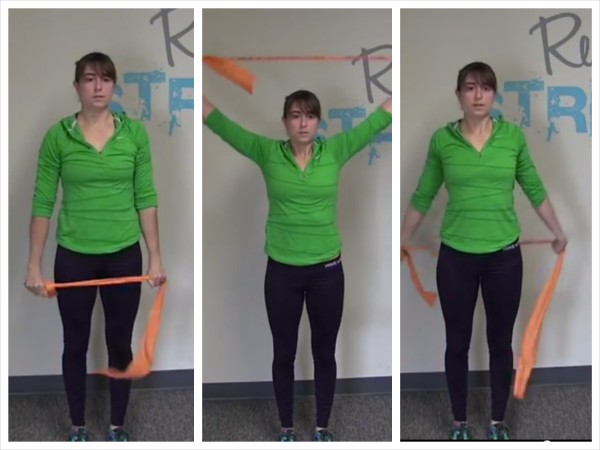
To do Shoulder Flossing, hold a band or towel in both hands with your hands about shoulder-width apart. You will adjust your hands in or out based on your mobility. Closer together requires more mobility, while further apart requires less. If you use a band, there will be some give so you can stretch the band if needed; however, with a towel there will be no give so make sure to set up correctly so that you can keep your arms straight through the full range of motion.
Stand up nice and tall with your chest pressed out as you hold the band in both hands in front of your legs.
Keeping your arms straight, lift your arms up overhead and then open them back up behind you. Reach them back toward the ground behind you, bringing them back down toward your butt. Then bring your hands back overhead and forward.
Because the band will stretch, it will give you a little play and allow you to open up wider if needed to get your arms in a full circle unlike the towel. Remember to hold in closer on the band as you gain more mobility and don’t need the band to stretch as much to allow you to complete the circle.
Wrist Extension Stretch – Proper wrist mobility is key to healthy, happy shoulders. If you lack mobility in your wrists, you risk injury to your shoulders. And because you sit with your wrists in flexion for hours at a time at your computer, it is important that you work on your wrist extension.
This is a great move to do if you plan to do push ups, handstands or crawling in your workout and want to keep your shoulders safe and healthy!
You can do this move with your hands up on your desk or kneeling on the ground.
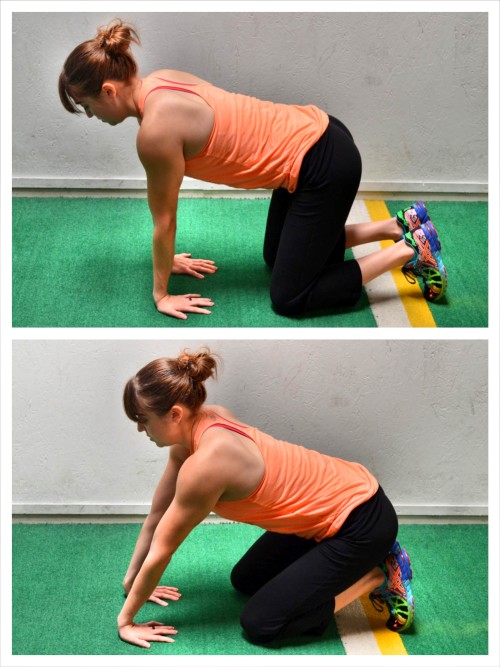
To do the Wrist Extension Stretch on the ground, kneel on the ground and place your hands down on the ground in front of you, palms down and fingertips turned back toward your knees.
Then sit your butt back, sitting back toward your heels, keeping the heels of your palms down on the ground as you sit back. Rock back forward and come back out of the stretch then sit back again, stretching down the inside of your forearms.
Quadruped Arm Rotations – Just like it is important to take care of your wrists, it is important to take care of your elbows. Proper elbow mobility is essential to keeping your shoulders healthy, not to mention your elbows, wrists and even your neck!

To do Quadruped Arm Rotations, set up on your hands and knees with your hands under your shoulders and your knees under your hips. Make sure your hands are pointing straight ahead and your palms are flat on the ground.
Then begin to rotate your arms without moving your palms. Rotate your elbow pits back toward your knees. Your shoulders will move, but you shouldn’t try to move your arms by moving your shoulders. You want to rotate your elbows.
Move slowly and do not bend your arms as you rotate.
Activation Exercises For Healthy Shoulders
Once you’ve gotten everything loose and mobilized, you then need to get the correct muscles activated and working.
If you don’t activate after stretching and rolling, you are never going to correct the problem and prevent the injury from coming back. While it is important to loosen everything up and restore proper mobility, if you don’t activate, you won’t get the correct muscles strong and working.
Once those muscles are activated and working, you can prevent the problem from reoccurring and prevent yourself from continuing to overuse small muscles that can’t handle the load.
Below are 6 Activation Exercises to activate the muscles of your back to help support your shoulders and prevent the small muscles of your rotator cuff and shoulder from becoming overworked. These moves will also help strengthen your posterior deltoid, the back of your shoulder, which is often weak in comparison to the fronts of our shoulders that get worked with all the pressing movements we do.
Straight-Arm Shoulder Extensions – This is a great move to strengthen the muscles of your upper back as well as your triceps and posterior deltoid. This move will also force you to stand up tall to make sure that the correct muscles work, which will help improve your posture.
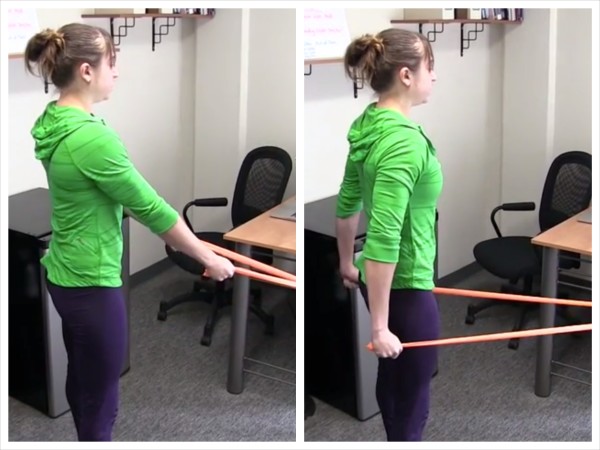
To do the Straight Arm Shoulder Extension, anchor a band at about hip height and hold an end in each hand.
Facing then anchor point, step away so there is tension in the band as you stand with your arms out straight slightly in front of you. Stand up nice and tall with your feet about hip-width apart.
Then, keeping your arms straight and chest pressed out, pull back on the band. Do not cave or round forward as you pull back on the band.
This movement doesn’t have to have a huge range of motion. Just focus on your back, the backs of your shoulders and your triceps pulling the band back as your arms stay straight. Pinch your shoulder blades down and back as you pull back. Keep your chest pressed out and engage your abs so you don’t arch your low back as you pull the band back.
Pull the back back, extending your shoulders and hold for a second or two then relax your arms back forward and repeat.
Do not shrug your shoulders as you pull the band back. Also make sure your triceps don’t do all the work. Focus on your back working as you maintain a nice tall posture.
Scapular Band Flyes – A strong back and the ability to properly retract your shoulder blades is important for shoulder health. Proper scapular retraction means you can correctly engage the muscles of your back and prevent your shoulders from becoming overworked and strained, not only during pulling exercises, but also pressing exercises.
The Scapular Band Flyes will also help improve your posture as they strengthen your back.
Below are three different Scapular Band Flyes you can use to strengthen your back from a few different angles while working on proper shoulder blade mobility.
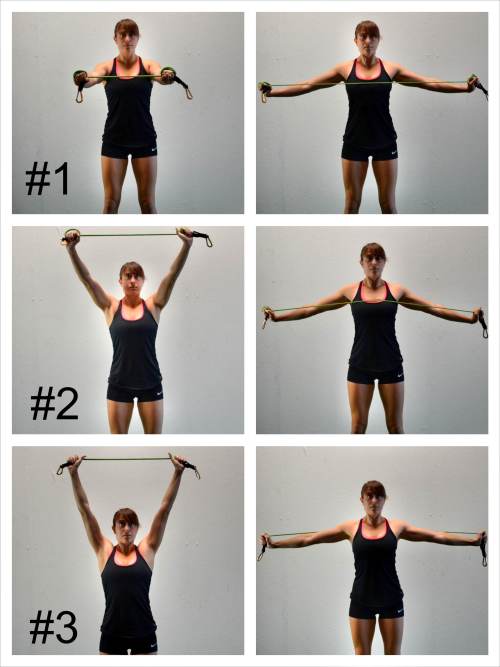
To do the Basic Scapular Band Fly (the straight on fly), hold the resistance band in both hands with your hands about shoulder-width apart. If you hold in closer, it will make the move harder. Just make sure you can properly fly your arms out without shrugging your shoulders. Press your chest out so you are standing nice and tall and keep your neck and shoulders relaxed. Do not shrug. Then raise your arms up straight in front of you at about shoulder height or right below. Keeping your arms straight, pull out on the band to open your arms out to the sides as you bring the band in to your chest. Pinch your shoulder blades down and together as you open and stretch the band. Do not let your shoulders shrug up as you pull the band. Hold with your arms open for a second or two and feel your back working. Then bring your arms back together so your arms are about shoulder-width apart again. Make sure there isn’t slack in the band even when you bring your arms back in front of you. Repeat the fly. Do not let the band pull you or let your elbows bend as you fly your arms open. If you have to bend your arms to do the fly or if your shoulders shrug up, you may want to go lighter or not hold in as close if your hands are closer together than shoulder-width apart.
To do an overhead angled Scapular Band Fly, you will hold the band overhead in front of you with your hands about shoulder-width apart. Then pull your arms straight out and down to shoulder height as you draw your shoulder blades down and together to bring the band down to your chest. Your arms should stay straight the entire time as you bring the band down to your chest. Press your chest out and make sure you keep your shoulders and neck relaxed as you fly your arms down and open. Pinch your shoulder blades down and together to feel your back working to perform the fly. Then slowly bring your hands back up overhead and repeat the fly.
Another variation is the Behind-The-Head Scapular Band Fly. It is an overhead move in which you pull the band down behind your head. Hold the band with your hands about shoulder-width apart and start with your arms straight up overhead. Then pull your arms straight down and out to the sides to pull the band down toward the back of your shoulders behind your head. Keep your chest pressed out and draw your shoulder blades down and together as you pull the band down. Pull it behind your head and bring your arms straight out to the sides so that they are about at shoulder height. Once the band reaches your shoulders, slowly bring it back overhead and repeat. Don’t jut your head forward as you perform the fly. Stand tall and keep your chest pressed out so that your back works to fly the band down behind your head.
Scapular Push Ups – This is a great move to help strengthen the muscles that control your shoulder blades and help stabilize your shoulders. It will get your back muscles and serratus anterior activated and working to promote shoulder health and a full range of motion.
The Scapular Push Ups will also improve your mind-body connection and allow you to properly engage the muscles of your back to mobilize and move your shoulder blades. We often lack the coordination and the ability to more our shoulders blades properly. This lack of movement, and the inability to retract our shoulder blades, can lead to shoulder pain and injury and prevent us from truly strengthening or working our back properly!
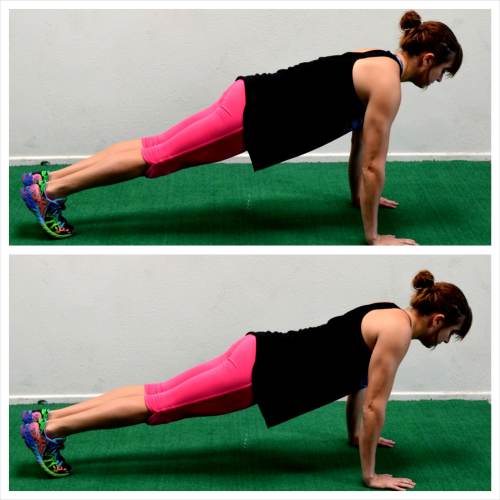
To do the Scapular Push Up, set up in a high plank position with your hands under your shoulders and your feet together. In this plank position, your body should be in a nice straight line from head to your heels. Brace your abs and drive back through your heels to engage your core.
Then, without bending your elbows or dropping your hips, pinch your shoulder blades together. Do not tuck your chin toward your chest or jut your head forward as you move your shoulder blades. Do not let your core wiggle or your hips sag just so that it feels like a bigger range of motion. Your core needs to stay tight for this move to really work on your scapular mobility and engage your serratus anterior. Your elbows also shouldn’t bend to try to increase your range of motion.
You are not doing a push up. This is a very small range of motion where you are simply focused on pinching your shoulder blades together. Just pinch your shoulder blades together and then relax or even round your back up out of it toward the ceiling (rounding your back at the top is another variation but can be very useful for correcting certain push up problems).
Keep your core tight as you pinch your shoulder blades together and make sure to feel your back working and not just your shoulders shrugging or your core sagging toward the ground.
As you get stronger and build the mind-body connection you will find your range of motion increases. If you struggle to pinch your shoulder blades together without wiggling your core or bending your elbows, go down to your knees as if doing a push up from your knees. If you still struggle, bring your knees under your hips and do this from the quadruped position. Take your core out of the equation until you have the mind-body connection to properly activate your back to move your shoulder blades.
You can also do Scapular Push Ups from your forearms or even do this type of scapular mobilization push up from even the downward dog position.
Band Pull Downs – Band Pull Downs are a great way to activate your lats and upper back while also improving your scapular retraction. This is a great move to not only activate your back to help protect your shoulder but also strengthen your back for Pull Ups.
Often because of our posture, aka sitting hunched over a computer, the big muscles of our back don’t engage correctly, leading our shoulder to do work it shouldn’t while also preventing us from being able to do awesome moves like the Pull Up.
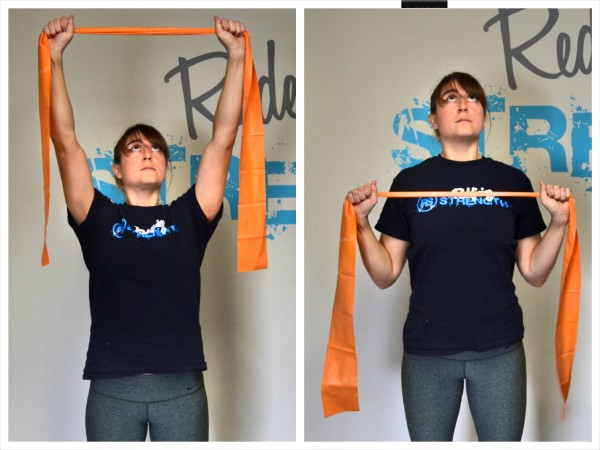
To do Band Pull Downs, you can do them with a Mini Band, a Resistance Band or a Theraband. You don’t need a very heavy resistance to make this move work. You can even use a towel. Just use something to help remind you to activate and pull with your back.
If you use a band, hold the band in both hands with your hands about hip-width apart. Slightly pull out on the band so that there is tension on the band. Press your chest out and reach the band overhead, keeping the band tight between your hands. You may need to adjust your hands in closer if the band is light. You want to pull out on it so your hands are not much wider than shoulder-width apart at most.
Then pull the band down toward your chest, as if pulling your chest up to the bar during a Pull Up. Pinch your shoulder blades down and back and feel your back working to pull the band down. Drive your elbows down to the ground and slightly back as you pull the band down keeping it tight between your hands.
You can either hold at the bottom of the pull or slowly reach the band back overhead to complete repetitions. If you do repetitions, move slowly and make sure to maintain tension on the band the entire time. Focus on really pulling the band down with your back while “leading” with your chest.
Do not arch your low back as you perform the pulls even though you want to press your chest out. Make sure you also don’t simply feel the outsides of your shoulders working, but instead feel your back. If you only feel your shoulders, you may be using too heavy a band or you may be too focused on pulling out on the band instead of down.
Mini Pull Ups – The Mini Pull Up is a great way for you to start learning how to retract your shoulder blades and engage your back during an actual compound exercise. While activation moves are important, it can still sometimes be a struggle to transfer that activation to actual movements during your workout.
So the more you can use more compound movements, or movements that simplify those compound exercises while learning how to activate your back, the better off you will be when it comes to activating the correct muscles during your workouts.
The Mini Pull Ups are also a great way to work on that initial pull up from a dead hang during the Pull Up. Beginners may need to keep their feet on the ground for assistance.
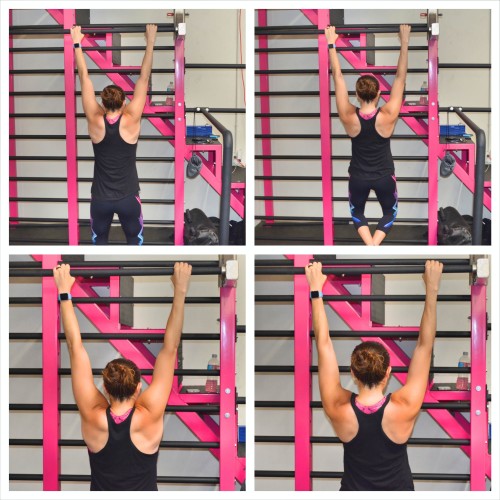
To do the Mini Pull Ups, hang from the bar with your palms facing away from you (you can also do this with palms facing toward you for a Mini Chin Up). Your hands should be about shoulder-width apart although you can do it with them wider apart or closer together as well.
Then, hanging from the bar, press your chest out and pull your shoulder blades down and together to lift yourself up. You will not bend your elbows. It will almost feel like you’ve gone from shrugging to unshrugging your shoulders. Feel your back engage as you draw your shoulder blades together.
Remember, don’t bend your elbows and turn this into a pull up. It doesn’t matter how big a range of motion you get as long as you focus on engaging your lats to pull your shoulders down. Make sure to press your chest out and retract your shoulder blades bringing them down and together. Feel your back engage and pull you up toward the bar even though your arms aren’t moving.
Then relax out and repeat. Remember, you are not bending your elbows to make this movement bigger! You can put your feet on the ground if you aren’t able to lower your shoulders and lift yourself up while handling your whole bodyweight. If you can’t get your lats and back to engage, take some of the load off by using your legs just a little bit.
Hanging Shoulder Circles – Activate your back while mobilizing your shoulders with the Hanging Shoulder Circles. This move will also improve your mind-body connection while teaching your back to engage and your shoulder to work safely through a full range of motion.
Proper mobility while the correct muscles engage is key to shoulder health.
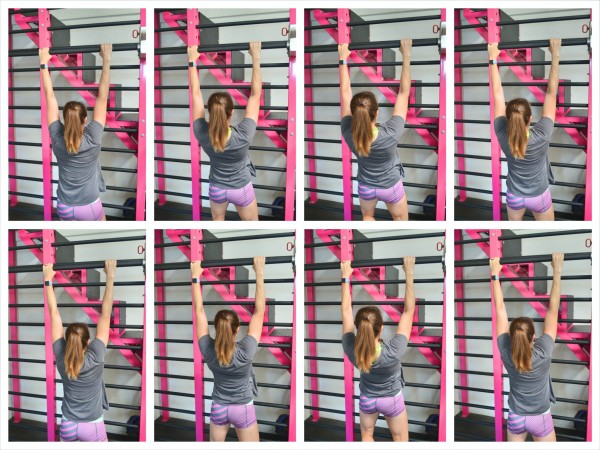
To do Hanging Shoulder Circles, hang from a bar with your palms facing away and your hands about shoulder-width apart. The movement will be very similar to the Mini Pull Up, but instead of simply lifting and lowering, you will circle forward or backward as you retract your shoulder blades.
To do the forward circles, pull down on the bar to lift your chest up and forward toward the bar. You will retract your shoulders down and back. Keep your lats engaged and don’t shrug as you rotate your shoulders to move backward.
Once back, begin to relax and lower back down and around so you can again engage your lats and press your chest out to lift up and forward. Feel your back engage to help you circle forward up and around before relaxing down and back.
To rotate backward, you will first circle back and down before lifting up and retracting your shoulder blades as you “unshrug” your shoulders. You will almost feel like you are slightly pushing back from the bar as you press your chest out and circle to lift yourself up.
Then, without shrugging, come forward before lowering down and back around to repeat the circle.
Complete a few circles one direction then switch and do them the other way.
Strengthening Exercises For Healthy Shoulders
Once you’ve gotten the correct muscles activated, you are ready to start strengthening and building those muscles.
All too often we skip right to the strengthening stage, but if the correct muscles aren’t activated and working, we risk not only injury, but also not getting the full benefit of the lifts we are doing.
If you want to strengthen your back to keep your shoulders healthy, you have to first activated it. Otherwise you are going to compensate and overuse smaller muscle groups when you row or lift.
So once the muscles are activated, you want to strengthen them with these 8 moves. Strengthening your back and the muscles around your shoulders can help prevent poor posture, imbalances and injuries from returning.
Back Flyes – We all too often work only the fronts and sides of our shoulders, leaving our posterior deltoid weak and underdeveloped. Back Flyes are a great exercise to help us strengthen the backs of our shoulders while also working our upper backs.
This is a must-do move not only if you have shoulder pain, but also if you have rounded shoulders or poor posture.
To do Back Flyes, you can use a Suspension Trainer or light dumbbells. To do the Suspension Trainer version, click here.
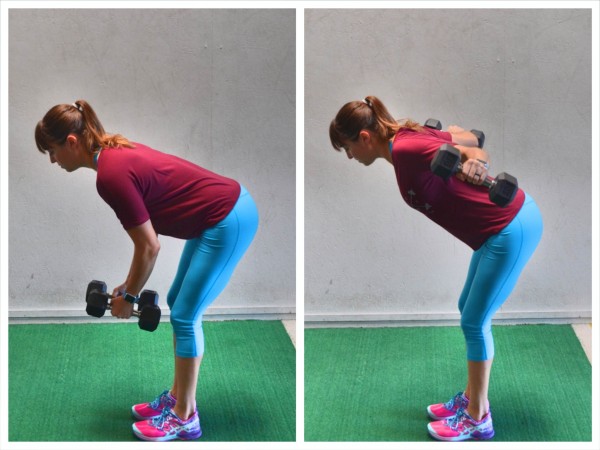
To do Back Flyes using dumbbells, hold a light dumbbell in each hand. Start light so that you can focus on your upper back and the backs of your shoulder’s working without engaging your upper traps, neck or lower back.
Hinge over at the hips holding the weights with your arms hanging straight down toward the ground. Keep your back flat and slightly bend your knees. Make sure to drop your chest to about parallel to the ground. If you start to stand back up, you could start to overuse your upper traps instead of using your upper back. You do not want to turn this into an upright row.
Then, bracing your abs, fly your arms out to the side. Keep your elbows soft as you lift your arms out to the sides and back toward the ceiling at about, or just below, shoulder height. Pinch your shoulder blades together as you fly your arms open and really feel your upper back and the backs of your shoulders working. Keep your neck relaxed as you fly.
Lower back down and repeat the fly. Try not to swing, but really focus on using your back to lift. Also, make sure to keep your elbows soft as you fly your arms up and out.
If you feel your neck and upper traps engaging, you can place your head against the wall or on top of a bench. Also, make sure your low back doesn’t engaged as you keep your back flat. You may need to brace your abs more or bend your knees slightly, especially if your hamstrings are tight.
Inverted Rows – Inverted Rows are another great exercise to strengthen your back. This move will work your upper back as well as your lats. It is a great move to really develop your back not only to help protect your shoulders, but also improve your Pull Ups.
Just make sure you actually feel your back performing the pull and not your arms. It is very easy to use your arms and not your back, which is why doing activation moves before your workout is key!
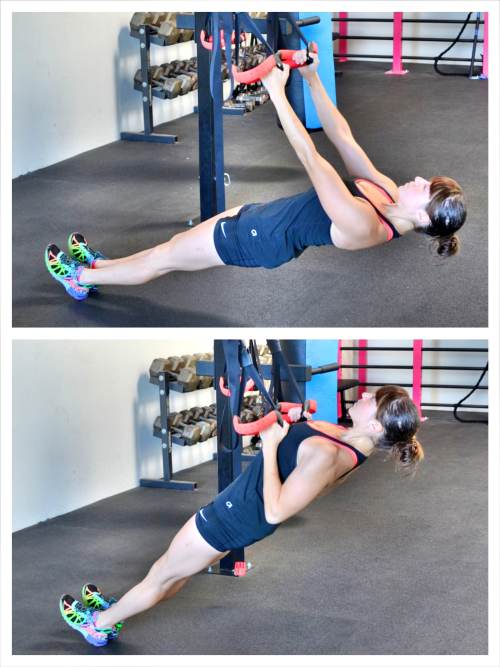
To do the Inverted Row using a Suspension Trainer, hold a handle in each hand with your palms facing in. You can change your grip to work your back in different ways. An underhand grip can even be good if you struggle to feel your back working. Holding the Suspension Trainer, walk your feet forward so that your body is at an incline. The closer to parallel to the ground you get, the harder the move will be.
Extend your arms to hang from the straps as you press your chest out and engage your core and glutes and keep your legs straight and your body in a nice straight line. You want a nice straight line from your head to your heels. Do not let your low back arch or your hips sag toward the ground. Feel tension in your upper back before you even move to row up.
Then drive your elbows down and back to row your chest up to the handles. Keep your body in a nice straight line as you row up and do not bounce off the bottom. Keep your wrists straight as you row and do not shrug your shoulders. Feel your back pulling to row you up.
Lower back down and repeat. Do not lose tension at the bottom. Make sure to keep the chest pressed out and your body in a nice straight line. Do not swing to row back up. Also, do not tuck your chin in toward your chest. You want your head to stay in line.
Make sure to feel your back working to row and not just your arms. Focus on feeling your back pull and make sure you don’t shrug your shoulders. If you feel yourself losing form, walk your feet back so that you are more vertical.
For variations of the Inverted Row, click here.
Handstands – When most people see “handstands” they think, “That move’s not for me.” But handstands are a great move that everyone should include in their workout routines – they just need to make sure to pick the correct variation!
Handstands are a great way to strengthen your entire upper body. They are a great way to learn how to stack your shoulder properly and promote proper thoracic extension. They can help build shoulder strength and stability while also working your core.
Make sure to progress slowly and include the wrist foam rolling and stretching moves to improve your wrist mobility as you work on your handstands.
Beginners will want to start with the Downward Dog while more advanced exercisers can do handstands against the wall or even freestanding variations.
Downward Dog is a great way to strengthen your shoulders while improving your thoracic extension and upper body mobility. It can stretch your lats and even your triceps while working your shoulders, arms, back and core.

To do the Downward Dog, start in the high plank position with your hands under your shoulders and your feet about hip-width apart.
Without walking your hands back toward your feet, push your butt up toward the ceiling as you press your chest back toward your legs and drive your heels down toward the ground. Keep your arms straight as you press your chest back and try to get your biceps by your ears. Make sure to press through your entire hand and not simply rock toward the outside of your palms. Feel your fingers gripping the ground.
As you hold, focus on getting your back flat and a nice straight line from the heels of your hands up to your tailbone. You want your arms to be in line with your torso (aka your biceps by the ears).
As you press through your hands to get your back flat, focus on also driving your heels down as you lengthen through your hamstrings. Really push your butt back and up as you hold the downward dog position and try to drive your heels down toward the ground. Breathe and try to relax deeper into the stretch.
While you may need to adjust your exact hand positioning, do not walk your hands in closer to your feet just to get your heels down. You want to make sure you are really focused on driving your chest back and extending your spine to improve your thoracic extension and stack your shoulders.
For the full Handstand Progression to fit your specific level, click here.
Halos – Halos are a great move to strengthen your shoulders through a full range of motion. Often when we stretch, we lose the mobility and flexibility we establish because we only strengthen through the same old range of motion. If you not only want to grow stronger, but retain your mobility, you need to perform strengthening exercises through the full range of motion.
That is why Halos are such a great move. They really strengthen all the muscles around your shoulder joint while working the shoulder through a full range of motion. Because this exercise is about the range of motion, don’t focus too much on going heavy with the weight especially to start. Focus on the range of motion and add weight slowly as long as you can maintain the same range of motion.
This move can also really strengthen your core if you focus on only moving at your shoulders.

To do Halos, stand with your feet no wider than hip-width apart. Stand with your feet closer together to make the move harder on your core. Hold a kettelbell upside down with one hand on each side close to where the handle attaches to the bell (you can also use a plate weight or dumbbell if you don’t have a kettlebell). Then raise the weight up so that it is in front of your face with your elbows down toward the ground. Stand tall with your shoulders down and back.
Squeeze your glutes and brace your core as you begin to circle the bell around your head. Bring the bell back and around your head to the right, pointing the bottom of the kettlebell back behind you as you circle it around the side of your head. Then drop it down behind your head, reach the bottom of the kettlebell down between your shoulder blades as your elbows rotate to point up toward the ceiling.
As you circle the kettlebell back and reach down between your shoulder blades, keep your core tight and don’t let your hips wiggle. Also, do not tuck your chin or move your head. You want to circle the kettlebell around as your head stays still.
Continue the circle and bring it around the other side, handles leading, and back in front of your face. Then switch the direction of your circle and go back the way you just came. Keep alternating directions until all reps are complete.
Do not tuck your chin or bob your head as you circle. Brace your abs and glutes so that you don’t rotate your hips as you circle and instead get all of the mobility from your shoulders and not your hips. Bracing your core will also protect your low back. Only the kettlebell is moving.
Planks with Shoulder Taps – This move is great to build shoulder stability and strength while learning how to support your shoulder with your core and back. It is also a great move to build core strength and stability.
The Planks with Shoulder Taps is a great way to learn how to engage your core and back to protect your shoulders during other planking exercises like Push Ups. Push Ups are basically moving planks that require you to engage your back and core, especially your serratus anterior, to support your shoulders and keep them safe as you press. This move helps you learn how to engage those muscles with less movement to build the stability.

To do Planks with Shoulder Taps, set up in a high plank position from your hands and toes (advanced) or hands and knees (beginner). Place your hands under your shoulders and closer together while your feet or knees should be wider apart to provide a more stable base. Bring your feet or knees together as the move becomes easier to make it harder on your core to stabilize. By having your hands closer together and more centered under your chest, you will also provide yourself with a more stable base. It is very important that you remain stable with this move or you can stress your shoulder.
Then, bracing your abs and engaging your glutes so that your body is in a nice straight line, lift one hand up off the ground, moving it slowly to touch the opposite shoulder. Keep your hips square to the ground and do not rotate as you lift your hand to touch your shoulder.
Do not let your butt go up in the air or your hips sag toward the ground. Touch your opposite shoulder then slowly place your hand back down on the ground. You want to move at a very controlled pace. Lift the other hand and tap your other shoulder. Do not rotate as you lift. Try to keep your body still and simply lift the hand to touch the opposite shoulder.
Overhead Carries – Overhead Carries are a great way to develop shoulder stability and to learn to engage your back to support and protect your shoulder. They will also work your core.
However, if you don’t have proper shoulder mobility and can’t extend up overhead, it may be safer to do a bottoms up carry or even a Farmer’s Walk. Both can still work your shoulder without requiring as much mobility.
A great Overhead Carry variation is the Unilateral Overhead Carry. This will work each shoulder independently and force your core to really engage to keep you balanced.

To do a Unilateral Overhead Carry, take one kettlebell and place your hand through the handle so that you can rest the kettlebell on the back of your forearm. If the kettelbell bothers you or you don’t have one, you can use a dumbbell instead. Press the weight up toward the ceiling, straightening your arm up so that your bicep is by your ear. Do not arch your low back or let your elbow bend as you hold the weight overhead. Keep your core tight and your arm up straight toward the ceiling and do not lean to either side or shrug your shoulders.
Then, keeping the weight stable overhead, walk around for the allotted distance or time. Then switch the bell to the other hand. Make sure you keep the arm straight overhead and that you don’t feel it in your low back.
If you can’t get your arm up overhead and you feel your neck and upper trap really taking over, try a Farmer’s Walk or Bottoms Up Carry. Here are some more carry variations to check out.
Single Arm Band Stability Presses – Another great way to develop shoulder stability and even correct imbalances in strength between your shoulders is to do unilateral presses. This forces each side to work independently so that your stronger side doesn’t take over.
And with the Single Arm Band Stability Press, you force each side to not only work independently, but also work to stabilize as you press the band. It will teach you to engage your back and core to stabilize your shoulder as you press and move.
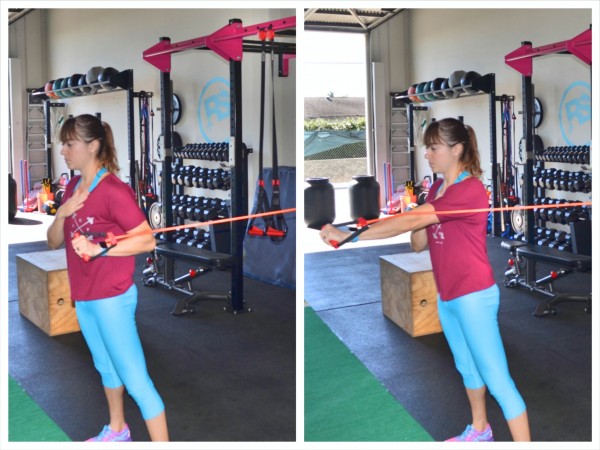
To do the Single Arm Band Stability Press with a resistance band, anchor the band behind you at about chest height and grab a handle in one hand. Step away from the anchor point so that there is tension in the band when your hand is in at your chest and stand with your feet even and about hip-width to shoulder-width apart. The wider your feet are, the easier the move will be.
Start with your hand up at your chest and your chest pressed out while your shoulder is relaxed down and back. Then press your arm straight out from your chest without shrugging or rotating. Do not let your core rotate as you press and make sure to press straight out from your chest. Do not let your hand press out and up. Make sure to keep your core tight and glutes engaged to make sure you don’t rotate as you press, but instead use your chest, shoulder and tricep. Also, feel your core and back engage to support and stabilize your shoulder.
Then once you press all the way out without letting your core rotate, bring the hand back in. Move slowly and move as if you were pressing both hands at the same time, aka your chest and hips should stay square instead of rotating.
Complete all reps on one side before switching. You can place the hand that isn’t working across your chest, down by your side or on your hip. Do whichever helps you fight the urge to rotate.
Crawls – Crawls are another great way to build shoulder stability and strength and learn how to engage your back while moving and using your shoulders. Crawls can also help you learn how to engage your lats to protect and support your shoulders.
There are a variety of crawls you can do to build your shoulder strength. But the Table Top Crawl is a great place to start. You can do this crawling variation forward and backward. Forward will work the shoulders but won’t be as tough on them as the backward crawl.
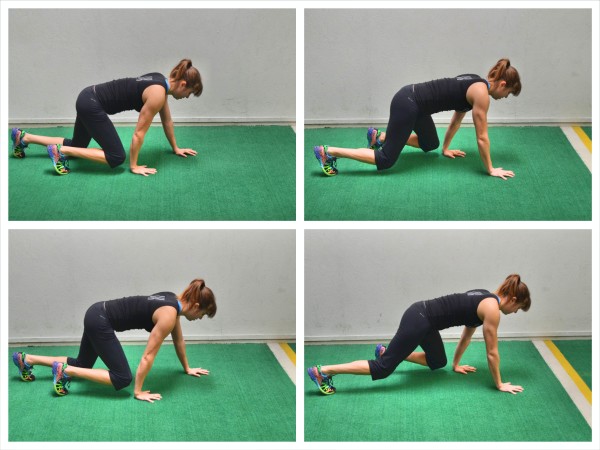
To do the Table Top Crawl, set up on your hands and knees with your knees under your hips and your hands under your shoulders. Flex your feet and lift up onto the balls of your feet with your knees only an inch or so off the ground.
Then take a step forward with your left foot and right hand, keeping your knees close to the ground and your back flat. Take a small step with the opposite arm and leg working together. Make sure to brace your core so that your hips don’t wiggle a lot side to side as you crawl forward.
Then step forward with your right foot and left hand. Keep crawling forward, moving the opposite arm and opposite leg together while taking small steps forward so that you don’t get too spread out and let your core break down. You don’t want your hips to start to wiggle and your butt to go up in the air. Also, keep your knees as close to the ground as possible. And feel your back engage to support your shoulders. Do not round your upper back or shrug your shoulders.
Once you’ve crawled forward, start crawling backward. Backward may be a bit more challenging and harder on the shoulders. Make sure to keep your steps small, especially when starting out, so that you don’t overload your shoulders.
To crawl backward, step back with the opposite arm and leg. Make sure you don’t get too spread out as you crawl backward so keep your steps small. If you reach too far back with your feet and get too stretched out, you are going to put a lot of pressure on your shoulders and then you wont’ be able to move fluidly. Your core will also break down. Keep you steps nice and short and compact to start with and your knees close to the ground. Make sure to brace your core and keep your butt down. Also, feel your back working to support your shoulders as you push backward.
Using these 4 Steps and these foam rolling, stretching, activation and strengthening exercises, you can help keep your shoulders healthy.
For an entire program to improve your shoulder health, and your posture in general, check out my RStoration Method – 10 minutes a day is all it takes!



